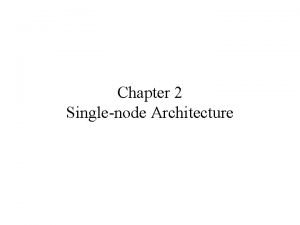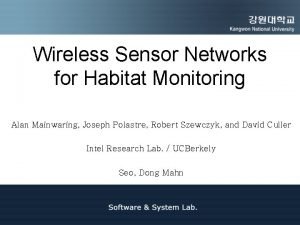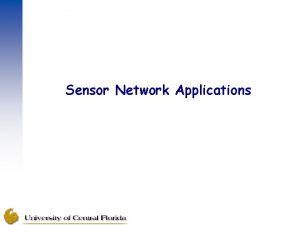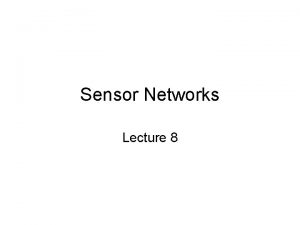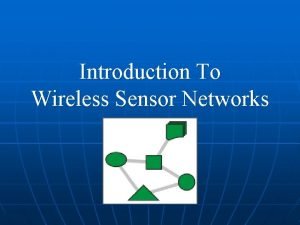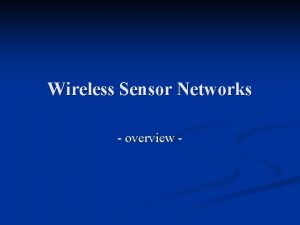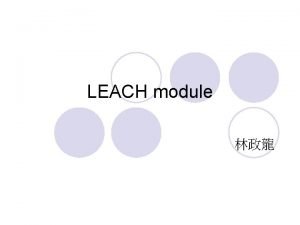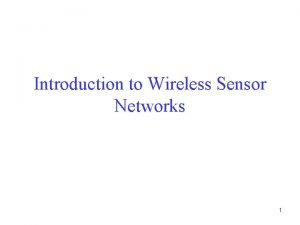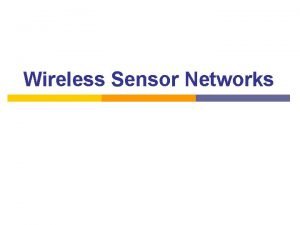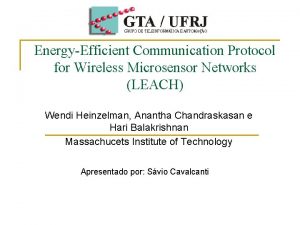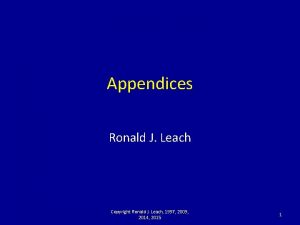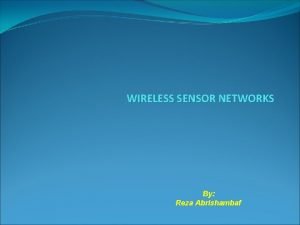LEACH Protocol for Wireless Sensor Networks An Introduction











- Slides: 11

LEACH Protocol for Wireless Sensor Networks

An Introduction… LEACH stands for Low-Energy Adaptive Clustering Hierarchy This WSN is considered to be a dynamic clustering method The reason we need network protocol such as LEACH is due to the fact that a node in the network is no longer useful when its battery dies

The Problem This protocol allows us to space out the lifespan of the nodes, allowing it to do only the minimum work it needs to transmit data

The Cluster-Head The LEACH Network is made up of nodes, some of which are called cluster-heads The job of the cluster-head is to collect data from their surrounding nodes and pass it on to the base station LEACH is dynamic because the job of cluster-head rotates

Direct v. Minimum Transmission The amount of energy used in figure (a) can be modeled by this formula: eampk(3 d 1 + d 2)2 Whereas the amount of energy used in figure (b) uses this formula: eampk(3 d 12 + d 22)

LEACH’s Two Phases The LEACH network has two phases: the set- up phase and the steady-state The Set-Up Phase ▪ Where cluster-heads are chosen The Steady-State ▪ The cluster-head is maintained ▪ When data is transmitted between nodes

Stochastic Threshold Algorithm Cluster-heads can be chosen stochastically (randomly based) on this algorithm: If n < T(n), then that node becomes a cluster- head The algorithm is designed so that each node becomes a cluster-head at least once

Deterministic Threshold Algorithm A modified version of this protocol is known as LEACH-C (or LEACH Centralized) This version has a deterministic threshold algorithm, which takes into account the amount of energy in the node…

What’s the Difference? REMEMBER: The goal of these protocol is to increase the life of the network The changes between the LEACH stochastic algorithm and the LEACH-C deterministic algorithm alone is proven to increase the FND (First Node Dies) lifetime by 30% and the HND (Half Node Dies) lifetime by 20%

An Example of a LEACH Network While neither of these diagrams is the optimum scenario, the second is better because the clusterheads are spaced out and the network is more properly sectioned

Bibliography “Low Energy Adaptive Clustering Hierarchy with Deterministic Cluster-Head Selection”; M. J. Handy, M. Haas, D. Timmermann; 2002; http: //www. vs. inf. ethz. ch/publ/se/IEEE_MWCN 2 002. pdf “Probabilistic Modeling of Leach Protocol and Computing Sensor Energy Consumption Rate in Sensor Networks”; Song, Dezhen; February 22, 2005; http: //www. cs. tamu. edu/academics/tr/tamu-cstr-2005 -2 -2
 Single node architecture in wsn
Single node architecture in wsn Wireless sensor networks for habitat monitoring
Wireless sensor networks for habitat monitoring Wireless sensor networks for habitat monitoring
Wireless sensor networks for habitat monitoring Wireless sensor network protocols
Wireless sensor network protocols Wireless sensor network ppt
Wireless sensor network ppt Forest geove
Forest geove Sensor wireless inc
Sensor wireless inc Telecommunications, the internet, and wireless technology
Telecommunications, the internet, and wireless technology Community leach pit
Community leach pit Tonic dialogue
Tonic dialogue What did richard maddox invent
What did richard maddox invent Victimas de ted bundy niña de 12 años
Victimas de ted bundy niña de 12 años
